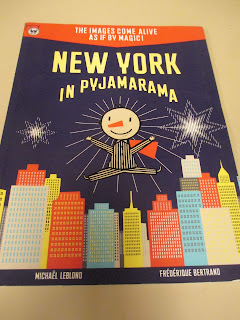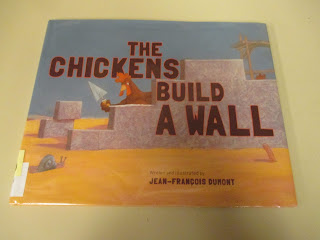How would you describe what color the wind is to someone who
can’t see?
How do you illustrate a trick poem from 17th
century?
How do you say and illustrate, “I am different! Can you find me?” in 16
different languages?
With the help of some translated picture books, of course!
I’m back today with three more titles for our “Outside the
Box” category. In these books, I was
most struck by certain illustrative aspects of the book and how it “plays” with
the text. Each of these books took
unique approaches to answering the questions I noted above through the use of
texture, cut-outs and seek-and-find elements.
These unconventional means make them memorable, but these elements are
so much more than gimmick to sell a book.
Each serves a unique purpose and cultural connotation. They make reading an experience for multiple senses. Let’s jump into these three titles right away
and I’ll elaborate as we go.
By: Anne Herbauts
Translated by: Claudia Zoe Bedrick
If you were reading closely above, you may have noted that I ended the first question about the color of the wind to someone who can’t see. I didn’t specifically say blind because nowhere in the text of this book by French author Anne Herbauts is the term used. (Kristi’s note – the jacket flap states “one day a blind child asks a grown-up” and I did read an interview with Herbauts stating that she was working with a blind child who asked her the question, thus inspiring the book. But the text of the story never states the “Little Giant” is blind. He is illustrated with his eyes closed, though). In fact, Herbaut, who won the France’s 2012 Prix Sorcières, children’s literature award for the book, leaves many points of the book’s plot open to the reader’s interpretation.
The story is of Herbauts’ “Little Giant” wondering what color the wind is. To answer his question, he goes on a walk, interviewing the animals and objects he encounters, asking them “What color is the wind?” Each has a different answer based on their own perspective. For example, the wolf replies “the wind is the dark smell of the forest” while to the bees it is “the color of sunshine.” (My personal favorite is the rain, who “knows nothing.” It stands out among all the other very specific answers.) At the end of his walk he comes upon someone “he senses is enormous” who tells him the wind is “everything at once. This whole book.” The enormous someone then takes the book and thumbs through its pages, allowing the Little Giant to feel the wind and its gentleness.
While all the simple text is beautiful and thought provoking, as the enormous someone suggests, it is the whole book that brings the story to another dimension. This isn’t just a readable book, it’s a touchable book. It begins on the cover, where the braille alphabet letters for the word WIND has been punched into the cover. The tactile reading experience continues through the entire book with cut-out shapes, embossed pages, raised textures, glossy smooth pages and rough textures to give an illusion of the feel of what or who the Little Giant is speaking to.
Herbauts uses textual elements to include references senses beyond sight and touch; answers to the Little Giant’s questions aren’t said they’re murmured, sighed and rumbled, the wolf mentions the ‘dark smell’ of the forest, sugary is used to describe the apple the Little Giant bites into. By combining all of these sensory elements the book transcends the idea of color being directly tied to sight. Whether the Little Giant is blind or not doesn’t truly matter – Herbauts' story gives him other ways to answer his own question from a myriad of different sources. It is the combination of the text, the illustrations and the tactile elements of the book that make the book unique. All of them are special on their own, but together they create an experience for the reader.
Source: 17th
Century English poem (Anonymous)
Illustrated by: Ramsingh Urveti
Graphic Design by: Jonathan
Yamakami
Before anyone calls me out, I will readily admit that this
is not a translated text. In fact, the
actual text comes from an anonymous source, dating back to England in the 17th
century. But this book was published by
Tara Books in 2011 and the work of Gond tribal artist Ramsingh Urveti and
Brazilian graphic designer Jonathan
Yamakami certainly, at the very least solidifies, its status as an
international picture book that deserves recognition here in the United States.
The text is a trick poem, or what Margaret
Atwood refers to as a writer’s version of trompe l’oeil.
Consider the opening lines of the poem:
I saw a peackock with a fiery tail
I saw a blazing comet drop down hail
I saw a cloud with ivy circled around
Here’s the “trick” of the poem, each descriptive clause (ex:
with a fiery tail) is written for the subject of the line below (ex: I saw a
blazing comet). If you do the same thing
for the next line, you end up with a “I saw a cloud drop down hail.” The entire poem in this same fashion if the
observant reader picks up the trick.
Playing on this idea, Yamakami came up with a die-cutting
technique to create a way to deceive the reader’s eye in relation to the
illustrations as well. Holes are cut
into strategic places in the page allowing the reader to “peak” through to the
next page. The holes connect the two
lines and break them at the same time.
Fortunately for you, I’ve tracked down a video so you can
see this beautiful book in action. Take
a minute and check it out
here.
Fun, right? And
unique! What stood out to me (and why I
wanted so much to include it in this post) is that it shows what a trick poem is.
Let’s be honest, even my English major self had to stop and really think
about what was the descriptive clause and subject line. Poetry often gets a bad rap, it feels distant
and unapproachable when presented in such stark terminology. If you described a trick poem that way to a
sixth grader then asked them to write their own I have a feeling most of them
would feel overwhelmed and lost, defeated before they even try. But what if you read them the poem in this
fashion? What if you had the ability to
show them as Urveti and Yamakami have so succinctly done?
Part of my hope with “outside the box” is that these books
present a new way of looking at something.
When I first got my hands on a copy of this book that is exactly how it
made me feel. It made something from
four hundred years ago new. I also
appreciated the English text being paired with Urveti’s Gond illustrations. We’ve come across a few other Gond artists
in other books I’ve mentioned. What
fascinated me even more was this
interview with Yamakami, in which he explains how the process to create a
book that presented both ways the poem could be read without actually printing
the poem twice took over two years to create.
Further, and we’ll get back to this with author and illustrator
relationships, he did not even work with Urveti during the book’s creation and
has yet to hear the illustrator’s reaction to the finalized product. There are so many things to explore in this
book, and before I get too long-winded (another post, another day on this one)
let’s take a look at one last book today.
This book as well, in full disclosure, was first published in
India. Technically then, it falls into
the international picture book category and is not actually a translated
text. But, it contains translation! And not just from one language, but from
sixteen different languages!
As the first page of the book states “This book celebrates
differences.” Not a unique concept right
now, especially with the cry for diversity and true representation of EVERY
child in the children’s literature community, but it is the way that Padmanabhan
blends text and illustration to represent differences in language makes this an
ideal choice for my outside the box category.
Padmanabhan,
who was born in Dehli, and spent her childhood in Sweden, Pakistan and
Thailand, has written children’s books, plays and a comic strip, Suki. (Kristi’s note: the strip started life as
Double Talk, was then published under the name Suki, and is now called Sukiyaki
in case you are interested in checking it out further.) The strip found new life in 2016 after a
hiatus following its initial run in the 1980’s and 1990’s. I point all this out because I often find it
fascinating to consider all the different mediums authors and illustrators
often work in. Plus, I found her
adult-geared comic strip enlightening and strikingly different than this
book. See, even Padmanbhan’s work
celebrates differences!
As I mentioned, the book features sixteen languages;
English, Hebrew, Hawaiian, Cree, Arabic, Filipino, Gullah, Mandarin, Hindi,
Spanish, Nahuatl, Italian, Navajo, Swahili, French and American Sign
Language. Each two-page spread asks the
question “Can you find me?” in each of the aforementioned languages with a
pronunciation guide underneath. One page
of the spread is the name of the language and an illustration of objects, one
of which is different than the others, whether it be in shape, size or
color. Answer the “can you find me?”
question, the reader is tasked with finding the different object in each
spread. On the opposite page is an
explanatory paragraph on the language itself, featuring facts such as its
origins, where it is the official language, in which direction the script is
read from and a few words an English speaker may know that actually originated
in the featured language. Some also have
additional words the reader can learn in the language, such as the colors of
the rainbow in Swahili or how to count to five in Cree.
This book fascinated me. I can honestly say that I was not
familiar with a few of the language it highlights. What I also appreciated was that the
illustrated differences that go with each language are not stereotypical
representations of those languages and the cultures they are associated with –
they’re really just everyday objects. In
that way Padmanabhan celebrates the language itself while adding an interactive
feature to the book.
Hopefully I’ve been able to show that these books are not just about their illustrative gimmicks. They are unique in the way they blend those illustrative tactics with textual elements to create an entire experience for the reader. Also, I found this information that was announced in Publisher’s Weekly a few weeks ago about Macmillan Children's Publishing Group new yet unnamed imprint extremely relevant to the type of books I’m including here. Macmillan stated the imprint would be "centered around imaginative and innovative books that inspire kids to explore, learn, and have fun while helping them develop the skills to do so." They went on further to say “our vision as an imprint is interactive books, playful books, substantive, useful, and informative books in formats kids have never seen before.” Seems to me like they may consider looking at some of these international and translated texts that are already doing that!
Here’s to hoping your day is filled with treats and not tricks, readers. We’re going to finish off the Outside the Box category with one “stinky” post I guarantee you won’t want to miss.

























































